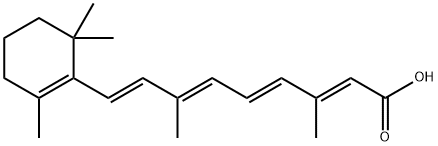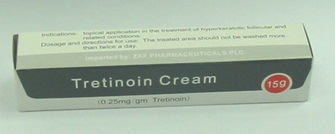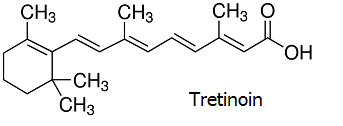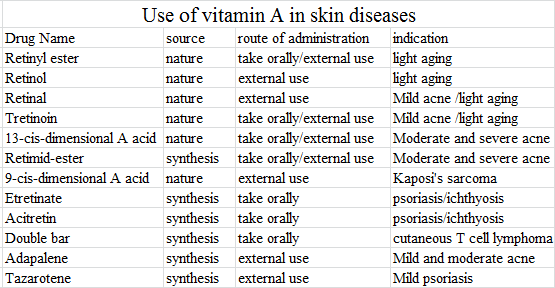

Tretinoin
| Price | USD1.00 |
| Packge | 1KG |
- Min. Order:1G
- Supply Ability:100KG
- Time:2019-07-06
Product Details
- Product NameTretinoin
- CAS No.302-79-4
- EINECS No.206-129-0
- MFC20H28O2
- MW300.44
- InChIKeySHGAZHPCJJPHSC-YCNIQYBTSA-N
- Appearancepowderyellow
- storage temp. -20°C
- Melting point 180-181 °C (lit.)
- Water Solubility insoluble
- Boiling point 381.66°C (rough estimate)
- density 1.0597 (rough estimate)
AD68
| Tretinoin Basic information |
| Product Name: | Tretinoin |
| Synonyms: | TRETINOIN;TRETINOIN VITAMIN A ACID;TRANS-RETINOIC ACID;TRANS VITAMIN A ACID;VITAMIN A ACID;VITAMIN A ACID, ALL-TRANS;RETINOIC ACID;RETINOIC ACID, ALL TRANS |
| CAS: | 302-79-4 |
| MF: | C20H28O2 |
| MW: | 300.44 |
| EINECS: | 206-129-0 |
| Product Categories: | PHARMACEUTICALS;Active Pharmaceutical Ingredients;APIs;Biochemistry;Terpenes;Terpenes (Others);Vitamins;Intermediates & Fine Chemicals;Retinoids;Intracellular receptor;API;intermediates;Inhibitors |
| Mol File: | 302-79-4.mol |
 |
|
| Tretinoin Chemical Properties |
| Melting point | 180-181 °C(lit.) |
| Boiling point | 381.66°C (rough estimate) |
| density | 1.0597 (rough estimate) |
| refractive index | 1.4800 (estimate) |
| storage temp. | 2-8°C |
| form | powder |
| color | yellow |
| Water Solubility | insoluble |
| Sensitive | Light Sensitive |
| Merck | 14,8165 |
| BRN | 2057223 |
| Stability: | Store Dry in Freezer at -20°C for up to 1 year; in Solution at -20°C for up to 3 Months. |
| InChIKey | SHGAZHPCJJPHSC-ZVCIMWCZSA-N |
| CAS DataBase Reference | 302-79-4(CAS DataBase Reference) |
| EPA Substance Registry System | Retinoic acid(302-79-4) |
| Safety Information |
| Hazard Codes | T,Xn,N |
| Risk Statements | 22-63-38-20/21/22-51/53 |
| Safety Statements | 53-26-36/37/39-45-36/37-61-24/25 |
| RIDADR | 3249 |
| WGK Germany | 3 |
| RTECS | VH6475000 |
| F | 7-8-16-23 |
| TSCA | Yes |
| HazardClass | 6.1(b) |
| PackingGroup | III |
| Hazardous Substances Data | 302-79-4(Hazardous Substances Data) |
| Toxicity | LD50 (10 day) in mice, rats (mg/kg): 790, 790 i.p.; 2200, 2000 orally (Kamm) |
| Tretinoin Usage And Synthesis |
| Dermatology drugs | Tretinoin is commonly used in dermatology drugs, which is the department of vitamin A (Victoria methanol) metabolic intermediates.It mainly affects the growth of bones and epithelial metabolism, can promote epithelial cell proliferation and updates, and can inhibit the proliferation and differentiation of keratinocytes, so hyperkeratosis can be back to normal. Therefore many complete or incomplete keratosis, hyperkeratosis of diseases have a certain therapeutic effect, treat a variety of skin diseases. The use of the drug can penetrate topical skin quickly, enable significantly increased epithelial cell turnover. This class of drugs has strong and rapid inhibition on the secretion of the sebaceous glands, can reduce sebum secretion. In addition, the product also has anti-tumor, promote wound healing and anti-inflammatory effects. |
| Clinical application | Tretinoin is mainly used in the treatment of psoriasis, ichthyosis, follicular keratosis, acne, lichen planus, verrucous epidermal nevus, impetigo, vitiligo, lichen psoriasis, the face of pityriasis alba, etc. In addition, the drugs also have some preventive effect on skin cancer.  Tretinoin Cream |
| Physicochemical property | It is a yellow needle crystal, with a similar smell of vitamin acetate. Soluble in methanol, ethanol, acetone, chloroform, dichloromethane , also in vegetable oil and fatty. In case of light, it is thermal instability, suck up moisture in the air, polymerization and metamorphism in water. The melting point of all trans-vitamin A acid is 182~180°C, the melting range of which is mixed with a small amount of isomers is 170~190°C. Tretinoin structure |
| Pharmacological action | This product can induce epidermal hyperplasia, and improve the granular layer and the cell layer thickness.It can influence the silk protein process and the formation of cross-linked film and promote the differentiation of epidermal granular layer cells in the late stage of the differentiation of the epidermal cells by affecting K10, K1 keratin solution. This product can significantly inhibit the formation of experimental acne, prevent and eliminate acne lesions. Tretinoin also affect melanocyte cell melanogenesis , it has more than a number of functional points, having inhibitory effect on the activity of Tyrosine hydroxylase, dopa oxidase and two hydroxyindole oxidase three catalyzing enzyme, so as to reduce the formation of melanin, reduce skin pigmentation. It has no effect on the normal black prime cellular tyrosinase activity and black pigment composition. |
| Pharmacodynamics | Tretinoin can increase the cell nucleus division and epidermal cell turnover, form of the stratum corneum cell adhesion, and easy to fall off. It can remove the existing acne, while inhibiting the formation of new acne, hair follicle epithelial replacement can prevent the blockage of the plug. The synthesis of keratin is also inhibited, which can affect the metabolism of epithelial cells. It has the effect of promoting the proliferation and differentiation of epithelial cells, and the dissolution of keratinocytes. |
| Pharmacokinetics | External use has a small amount of skin absorption, large area of application of the increase in absorption. About 5% of the amount of external use urine. This product is absorbed well, the blood can reach the concentration peak after 3 hours, blood concentration can reach 0.3~0.5mg/ml, after oral administration of 1 mg/kg. After oral absorption, it is widely combination with plasma protein and has half-life of 0.7 h in a mean elimination. After a single oral dose of 40mg, blood drug concentration can be up to the source metabolic level in 7~12 hours. Multiple oral administration has not seen in vivo accumulation, but the blood concentration of the drug is significantly decreased, which may be due to the induction of cytochrome P450 enzymes, and the elimination of the rate of increase and bioavailability. It mainly used in the liver metabolism, which is metabolites of glucose acid esters. 60% of metabolites is by renal excretion, and can also be excreted by bile but metabolite half-life is longer. |
| Vitamin A acid medicine | Vitamin A acid medicine is a kind of natural or synthetic existence with vitamin A activity of retinol (retinol) derivatives. The drug discovery is regarded as a new milepost for treatment of skin diseases and cosmetic pharmacology. In the last 20 years, the application of the dimension A acid has made great progress in the treatment of many skin diseases. So far, there have been 2500 retinoic acid derivatives. According to its development process and chemical structure, they can be divided into three generations: the first generation is class of non aromatic retinoid, tretinoin and isotretinoin as the representative. The second generation is class of single aromatic A acids, etretinate and acitretin as the representative; the third generation is class of aromatic dimensional A acid, aromatic methyl ethyl acetylene, adapalene and vitamin A acid ethyl ester as the represented. use of of vitamin A in skin diseases |
| The indications | Used in the treatment of acne vulgaris, especially the blackhead acne lesions, senile, fluorescent or drug skin atrophy, ichthyosis and various abnormal keratinization and pigment excessive calm skin disease, and psoriasis. |
| Usage dosage | (1) ointment: use 0.1% ointment for the other skin lesions and 0.05% ointment for acne skin lesions in the topical application. Clean the skin with warm water after one time every night. (2) gel: apply to the affected area. At the beginning of treatment , it can be taken one time every two days or every three days. Afterwards smear one time every night. |
| Adverse reaction | This product may cause skin irritation symptoms such as burning, erythema, swelling, desquamation, crusting, pigment increase or decrease, may make the skin lesions more obvious, but also showed that the drug is working, not aggravated illness. Most of the skin can be adapted and tolerated, the phenomenon can be gradually disappeared. If irritation persists or increased, you can take intermittent or suspended medication. |
| Precautions | (1) This drug is contraindicated in pregnant women and patients with the allergic to the Tretinoin, the A derivative of vitamin A, acute or subacute dermatitis, eczema, skin diseases. (2) Allergic caution. (3) Women should stop breastfeeding during the period of the nursing period. Women of childbearing age are prohibited during the period of pregnancy .Children with caution. (4) The product should avoid contacting with eyes and other mucous membranes (e.g., mouth, nose, etc.). Do not use in skin of wrinkling location and skin ulceration. (5) The site of using medicine, appearing the things such as burning, itching, redness, etc. should discontinue medication, and the local is washed clearly. Consult the doctor if necessary. (6) For the treatment of acne, the first few weeks ache can be temporarily intensified, but should continue to treat more than 6 weeks to reach the maximum effect. (7) The product should not be used in large areas, the daily dosage should not exceed 20g. (8) During the course of medication, do not use other drugs ,which can cause irritation and damage to skin, cosmetics and cleaning agents, so as not to aggravate the skin reaction, resulting in increase in drug absorption and cause systemic adverse reactions. (9) The sun can accelerate Tretinoin decomposition and stimulate heavier to the skin. Animal experiments suggest that Tretinoin can enhance the ability of ultraviolet radiation, so the product is most appropriate in the evening and bedtime application, the treatment process should avoid the sun, or the use of shading measures. |
| Drug interaction | (1)Tretinoin combining with light sensitive drugs can increase the risk of photosensitiveness. (2)Tretinoin combining with soap and detergents, containing keratolytic agents (such as peroxy benzoic acid, Resorcinol, salicylic acid, sulfur,etc), ethanol preparation, isotretinoin can aggravate irritation or dryness to skin, and therefore must be used with caution. (3) Tretinoin combining with sago cimetidine, cyclosporine and diltiazem, verapamil and ketoconazole, can cause an increase in the blood concentration of the drug, and may lead to retinoic acid poisoning. (4 Tretinoin combining with pentobarbital, rifampicin, phenobarbital, can cause the blood concentration of the product decreasing. (5) The product will affect the liver cytochrome P450 enzyme system, resulting in changes in blood concentrations of the drug. (6)Taking drugs oryzanol, vitamin B1, vitamin B6 with Tretinoin, can make headache relieved or disappeared, because of adverse reactions of the drug. There are Informations on Common tretinoin in the Department of Dermatology,incluing the pharmacological effects , pharmacokinetics, pharmacodynamics, indications, drug interactions, and adverse reaction of the drug, these were edited by Yuri Huang in the chemcialbook (2015-09-24). |
| Uses | (1) Applies to abnormal tyshiyongyupe of acne, fish phosphorus disease and abnormal psoriasis. (2) Resistance to abnormal skin drugs. (3) Tretinoin mainly affects the growth of bones and epithelial metabolism, can promote epithelial cell proliferation and updates, and can inhibit the proliferation and differentiation of keratinocytes, so hyperkeratosis can be back to normal. Therefore many complete or incomplete keratosis, hyperkeratosis of diseases have a certain therapeutic effect, treat a variety of skin diseases. Tretinoin is mainly used in the treatment of psoriasis, ichthyosis, follicular keratosis, acne, lichen planus, verrucous epidermal nevus, impetigo, vitiligo, lichen psoriasis, the face of pityriasis alba, etc. |
| Indications and Usage | Retinoic acid is a commonly used dermatological drug and an intermediate product in bodily vitamin A (dimethyl alcohol) metabolism. It has a similar odor to that of vitamin A acetate. It is easily soluble in methanol, ethanol, acetone, chloroform, dichloromethane, and it is also soluble in vegetable oil and fats. It is instable when in contact with light and heat, hygroscopic in air, and polymerizes and metamorphosizes when in contact with water. Retinoic acid also anti-tumor, wound-healing, and infection-resisting effects. It is mainly used clinically to treat psoriasis, hair follicle keratosis, acne, lichen planus, verrucous epidermis nevus, ureophora, vitiligo, pityriasis rosea, and facial pityriasis simplex, especially blackhead skin lesions, and senile, sun-induced, or drug induced skin atrophy, as well as various keratosis abnormalities and hyperpigmentation diseases. In addition, it also has certain preventative effects against skin cancer. Retinoic acid can significantly inhibit experimental acne breakouts. |
| Mechanisms of Action | Retinoic acid mainly affects bone growth and epithelium metabolism, it can promote epithelium cell growth and renewal, and it can inhibit keratinocyte growth and differentiation to correct hyperkeratosis. Thus, it has certain curative effects on diseases related to keratinization, hypokeratinization and hyperkeratinization. A localized application can penetrate the skin very quickly and cause significant growth in epithelial cells. Retinoic acid has a strong and rapid inhibiting effect on sebaceous glands and can reduce sebum secretion. Retinoic acid promotes epidermal growth, thickens the stratum granulosum and stratum spinosum, and affects K1 and K10 keratinysis in late stage epidermal cell differentiation to influence the siloxin to silymeric protein process and cross-linked coating formation, thus promoting epidermal granulosa cells to differentiate towards the cuticle layer. It regulates follicular sebaceous gland epithelium keratinization abnormalities to remove keratin plugs, thus being able to prevent and remove acne lesions, and follicular epithelial renewal can also prevent keratin plugs and acne formation. In addition, retinoic acid can also affect melanogenesis of melanocytes with a multi-site effect, and it can inhibit the activity of tyrosine hydroxylase, dopa oxidase, dihydroxyl indole oxidase, and other type-three catalytic enzymes, thus lowering the formation of melanin and reducing hyperpigmentation. It has not impact on normal human melanocyte tyrosinase activity and melanin content. |
| Pharmacokinetics | A small amount is absorbed by the skin through external use, and absorption increases as application area increases. Approximately 5% of the externally applied amount is excreted through urine. This product is well-absorbed when taken orally and reaches peak blood concentration in 3 hours. With an oral dosage of 1mg/kg, blood concentration can reach 0.3-0.5 mg/ml. After oral absorption, it will bind universally with serum protein, and its average clearing half-life is 0.7 hours. After a single 40mg dose, blood concentration reaches its endogenous metabolism level in about 7-12 hours. Multiple oral doses do not appear to accumulate in the body, but blood concentration will noticeably decrease, possibly due to the induction of cytochrome P450, thus causing the clearing rate to increase and bioavailability to decrease. It is mainly metabolized in the liver, and its metabolite is esterified glucuronic acid. 60% of the drug is excreted by the kidneys, it can also be excreted through bile, and its metabolite’s half-life is longer than that of the drug itself. |
| Drug Interactions |
|
| Adverse reactions | May cause skin irritations such as a burning sensation, erythema, swelling, desquamation, scabbing, or change in pigmentation. May cause skin lesions to become more obvious, but this means that the drug is taking effect, and not that the condition is worsening. Mostly tolerated or tolerable on the skin, and irritation may subside gradually. If irritation continues or worsens, use periodically or cease use. |
| Warnings and Precautions |
|
| Chemical Properties | Yellow-Orange Powder |
| Uses | keratolytic, antiacne, antineoplastic |
| Uses | antipruritic |
| Uses | Physiological metabolite of vitamin A. Effects gene expression via nuclear retinoic acid receptors (RAR); mediates cellular growth and differentiation |
| Definition | ChEBI: A retinoic acid in which all four exocyclic double bonds have E- (trans-) geometry. |
| General Description | Yellow to light-orange crystalline powder. |
| Air & Water Reactions | Tretinoin may be sensitive to prolonged exposure to air. Insoluble in water. |
| Reactivity Profile | Tretinoin may discolor on exposure to light. Tretinoin is extremely sensitive to exposure to light and, therefore, Tretinoin should be fully protected from light during all handling. Solutions are unstable in the presence of strong oxidizers. Tretinoin is incompatible with strong oxidizing agents. . |
| Fire Hazard | Flash point data for Tretinoin are not available; however, Tretinoin is probably combustible. |
| Biological Activity | Endogenous agonist for retinoic acid receptors. Also positively modulates PPAR δ receptors (K d = 17 nM). Promotes differentiation of embryonic stem cells (ESCs) into adipocytes, neurons and glia in vitro . |
Company Profile Introduction
Henan CoreyChem Co., Ltd, based on the original Zhengzhou Cote Chemical Research Institute, be brave in absorbing highly educated talents & overseas returnees; actively responded to Zhengzhou City High-tech Zone Government’s Special Care Policy, reorganized and founded in National University of Science and Technology Park, which is a high-tech, stock enterprise of high-end chemical Custom synthesis;The park was created by the People's Government of Henan Province, and proved by Ministry of Education and the National Science & Technology, taking the construction mode of "many college a park, and common development", mainly depends on Zhengzhou University and Henan University’s scientific research and talent advantage to set up Universities, scientific research institute and enterprise scientific research achievements transformation platform, to make high-tech enterprises incubate, is the new high-tech talent gathering base, high and new technology industry enterprise radiation base, colleges and universities technological innovation base.
Henan Coreychem Co., Ltd, facing global High-tech pharmaceutical raw materials, high complex new type intermediates, fine chemicals custom synthesis, scale-up production and Rare chemicals trade. Corey have well-equipped machine, strong technical force and considerate marketing team service. We also have rich experience advantage in basic research, small scale process development, scale-up, industrial technology development & production and cost control.
Recommended supplier
-
VIP1年
- Allmpus Laboratories Pvt Ltd
- 302-79-4 97.32
- Inquiry
- 2024-08-29
-
VIP1年
- Apionex Pharma Pvt Ltd
- Retinoic acid 98%
- Inquiry
- 2024-03-20
-
VIP1年
- SRIKEM LABORATORIES PVT LTD
- 302-79-4 98%
- Inquiry
- 2024-03-18
-
VIP1年
- Ralington Pharma
- Retinoic acid 98%
- Inquiry
- 2024-02-05
- Since:2014-12-17
- Address: No.967,15th Floor,Unit 7, Building 1, No.70 of DianChang Road, High-tech Development Zone, Zhengzho
INQUIRY
